Find the best brokers for micro futures, a type of futures contract designed to make markets more accessible by lowering margin requirements and reducing tick values. These contracts are typically one-tenth the size of standard futures.
At WR Trading, we’ve seen how micro futures can lower the barrier for retail traders, allowing them to gain exposure to global markets with a smaller upfront commitment.
To help you find the best brokers, we researched, tested, and compared multiple brokers that offer micro futures contracts, examining key factors such as regulation, costs, platform support, and customer service.
Here is a summary of these ten brokers (each with its main standout feature) before exploring them individually in more detail:
Broker:
Futures Fees:
Advantages:
Account:
$0.75 per micro contract
(No Platform Fees + Market Data Fees)
- Open an Account in under 5 minutes
- Multiple Exchanges (CME, CBOT, NYMEX, & more)
- MT5, TradingView
- Multiple Regulations
- Minimum Deposit: $100
- Personal Support
- Day Trading Margin 2%
- Best Overall for Beginners & Professionals
$0.49 per micro contract
(Only available for US Traders)
- Multiple regulations
- $100 Minimum deposit
- Plus500 WebTrader, Plus500 App
- Global Payment Methods
- No Market Data Fees
- Best For US Traders
$0.39 per micro contract
(Can Be Lowered By Special Plans)
- Futures Broker
- No Minimum Deposit
- 2% Day Trading Margin
- NinjaTrader Desktop, Web, and mobile
- Exchanges: CME, CBOT, NYMEX, COMEX, & more
from $0.22 per side
- Multiple platform integrations, e.g. TradingView
- Commission starting from $0.22 per side
- Demo Account available
- CFTC regulated
- EdgeProX, EdgeEQ
$0.60 per micro contract
- $100 Minimum Deposit
- Super Low Day Trading Margin (1.6%)
- CFTC regulated
- MetaTrader 5, Quantower, TradingView, & more
- Fast Chat Support
- Best For Multiple Platforms
$0.09 per micro contract
- Futures, Mini Futures, Micro Futures
- MT5, TradingView, Sierra Chart, Quantower, MultiCharts, Jigsaw
- Regulation: CFTC, NFA
- Multiple Exchanges (CME, CBOT, NYMEX, & more)
- Best For Low Costs
from $0.39 per side
- Futures broker
- CFTC regulated
- Low Commissions from $0.39 per side
- Minimum Deposit: $5
- Exchanges: CBOT, CME Group, ICE, Eurex, & many more
$0.25 per micro contract
(Can Be Lowered By High Volume Trading)
- No Minimum Deposit
- No Platform Fees
- Demo Account available
- IBKR GlobalTrader, IBKR Desktop, Trader Workstation (TWS), & more
- Best For Professionals
$0.39 per micro contract
(Volume Tiered)
- Demo Account available
- Ironbeam App & Trading Platform, TradingView, Sierra Chart, CQG, Jigsaw, & more
$0.50 per micro contract
- No Minimum Deposit
- 10% Intraday Margin
- Multiple regulations
- Demo Account available
- TradeStation Platform
- 600+ Futures
1. AvaFutures
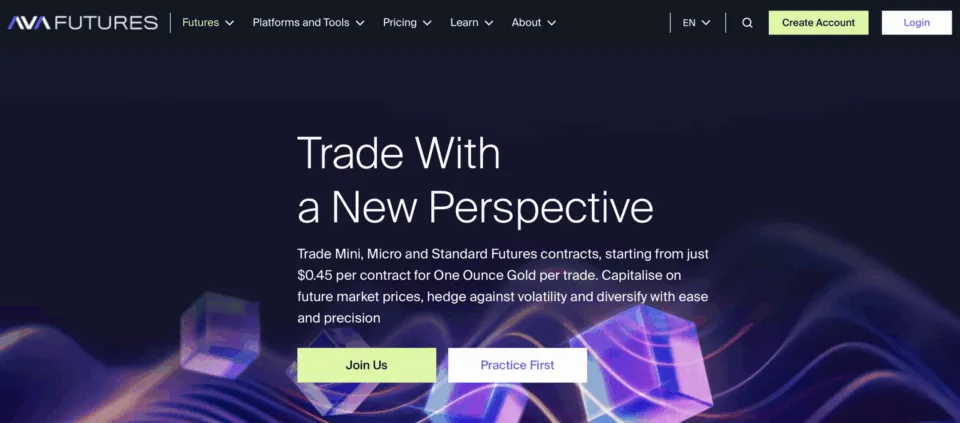
AvaFutures is the best micro futures broker overall, particularly for beginners and even for advanced traders. Although relatively new (launched in 2024), it benefits from the backing of the well-known AvaTrade. This brings a high level of regulation, where the broker is overseen in eight jurisdictions across multiple continents. Good support, easy account opening.
Opening an account is a straightforward process that takes just a few minutes. We also found AvaFutures’ support to be responsive and knowledgeable, whether we used the chatbot or spoke with a live agent.
Unlike many other futures brokers, AvaFutures has several globally recognised payment methods like VISA/Mastercard, PayPal and Skrill, which allow for low costs (no deposit/withdrawal fees).
The broker also provides 25-100 (depending on the deposit size) commission-free trades within 90 days for new traders. Alternatively, AvaFutures’ round turn micro contract fees are competitive (minimum $0.75 per side), where you can trade micro futures on seven asset classes.
As a bonus, traders can get free CME Group level 2 data once their account is verified and funded.
| Information | AvaFutures |
|---|---|
| Regulators | CBI (Ireland), BVIFSC (British Virgin Islands), ASIC (Australia), FSCA (South Africa), FSA (Japan), ADGM (UAE), CySEC (Cyprus), ISA (Israel) |
| Minimum deposit | $100 |
| Supported Trading Platforms/Software | MT5, TradingView, CQG |
| Available Accounts/Plans | MT5 Futures Account, TradingView Futures Account |
| Available Futures | Indices, energy, forex, interest rates, cryptocurrencies, metals, and agriculture |
| Minimum trading commission (on MES) | $0.75 per side |
| Base Currencies Supported | USD, EUR |
| Payment Options | VISA/Mastercard, wire transfer, PayPal, Neteller, Skrill, Klarna, Webmoney, POLi, Boleto, Perfect Money |
| Deposit/Withdrawal Fees | N/A |
| Available Customer Support Channels | Live chat, phone, email |
| Countries Accepted | 150+ (some sanction-targeted nations like Cuba, Iran, Syria, North Korea, Sudan, Yemen and Belarus would be restricted) |
Pros
- One of the best regulated futures brokers
- Offers popular, diverse funding options
- Reasonable minimum deposit
- Simple account range
- No deposit/withdrawal fees
Cons
- Limited trading platform support
- Only two account base currencies are supported
2. Plus500 US
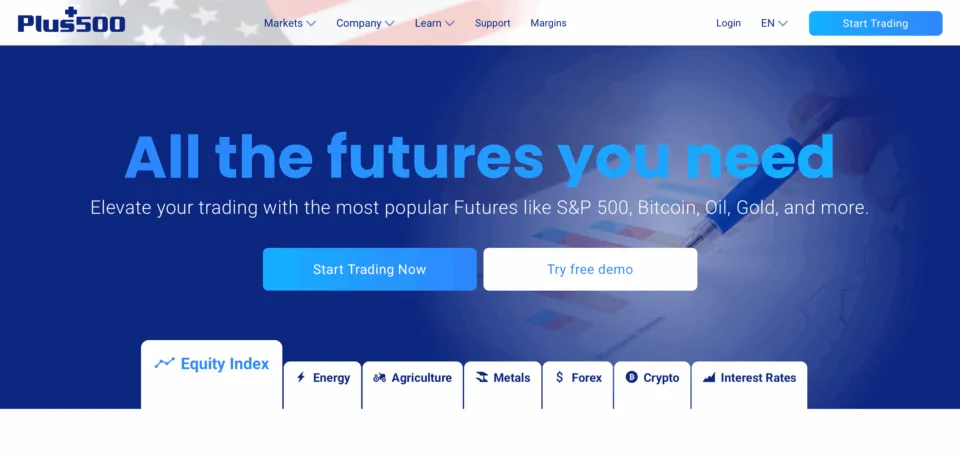
Plus500 US is another futures platform founded by an established name, Plus500. Launched in 2021, this US-based broker also provides an accessible platform for trading futures.
It focuses on low costs, with rates as low as $0.49 per side for micro contracts, and no platform, market data, routing, or inactivity fees. The minimum deposit is $100, another perfect feature for small accounts.
While traders are limited to the broker’s proprietary trading platform, this eliminates much of the extra fees common with third-party software.
Their selection of futures is broad, encompassing eight market categories, ranging from cryptocurrency to even interest rates. This is across many major US exchanges like the CME Group, ICE and CBOE.
| Information | Plus500 US |
|---|---|
| Regulators | CFTC (United States) |
| Minimum deposit | $100 |
| Supported Trading Platforms/Software | Plus 500 (proprietary) |
| Available Accounts/Plans | Standard |
| Available Futures | Crypto, equities, indices, energies, metals, forex, agriculture, interest rates |
| Minimum trading commissions (on MES) | $0.49 per side |
| Base Currencies Supported | USD |
| Payment Options | VISA/Mastercard (incl. Apple Pay and Google Pay), wire transfer, ACH |
| Deposit/Withdrawal Fees | N/A |
| Available Customer Support Channels | Live chat, email |
| Countries Accepted | N/A |
Pros
- Reasonable trading commissions
- Affordable minimum deposit
- Wide range of futures markets
- Popular choice of payment options
- 24/7 email help provided
Cons
- Only USD is the available base currency
- Supports only its proprietary trading software
- No phone support
3. NinjaTrader
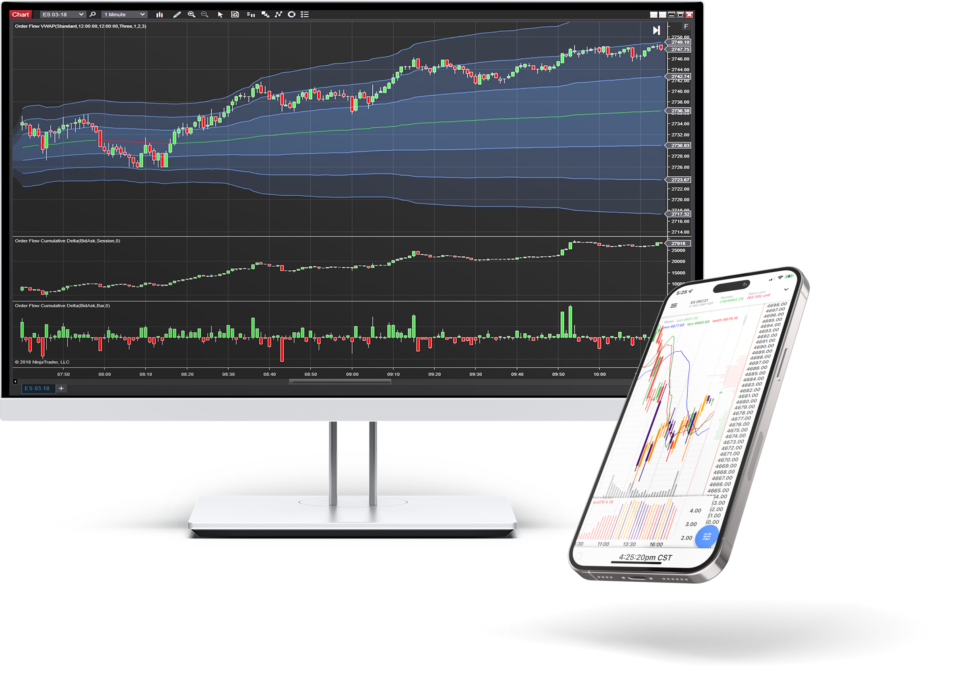
NinjaTrader is a synonymous name in futures and general online trading. This US-regulated company was formed in 2003, doubling up as a brokerage and a state-of-the-art charting platform.
As with many micro futures brokers, no minimum deposit applies. NinjaTrader’s minimum commission on the Micro E-mini futures of the S&P 500 is $0.95/contract per side. However, with a $99 monthly plan or a $1,499 one-time payment Lifetime plan, the minimum commissions for micro futures per side are $0.29 and $0.09, respectively.
The paid packages offer all of the premium features of NinjaTrader’s software, beneficial for active traders. These include real-time market data, ‘Market Replay,’ ‘Order Flow+’ and ‘Pulse Indicator’ real-time market sentiment. NinjaTrader is a widely lauded charting software and should be considered by serious traders.
| Information | NinjaTrader |
|---|---|
| Regulators | CFTC (United States) |
| Minimum deposit | N/A |
| Supported Trading Platforms/Software | NinjaTrader (proprietary) |
| Available Accounts/Plans | Free, Monthly, Lifetime (across Individual, Joint, IRA and Business) |
| Available Futures | Indices, energies, metals, crypto, US treasuries, agriculture |
| Minimum trading commissions (on MES) | $0.39 per side |
| Base Currencies Supported | USD, EUR, GBP, AUD, CAD |
| Payment Options | ACH, debit card, wire transfer, check |
| Deposit/Withdrawal Fees | Yes, $30 for wire transfer withdrawals (or currency equivalent) |
| Available Customer Support Channels | Live chat, phone, email |
| Countries Accepted | 100+ (US-sanctioned nations, EU nations, several African countries, India, and Canada are some restricted regions) |
Pros
- Long-standing futures broker
- Competitive trading commissions
- Advanced charting platform
- No minimum
Cons
- Catered mainly for US citizens
- No third-party trading platform integration
- Plans may be too expensive for some
4. EdgeClear
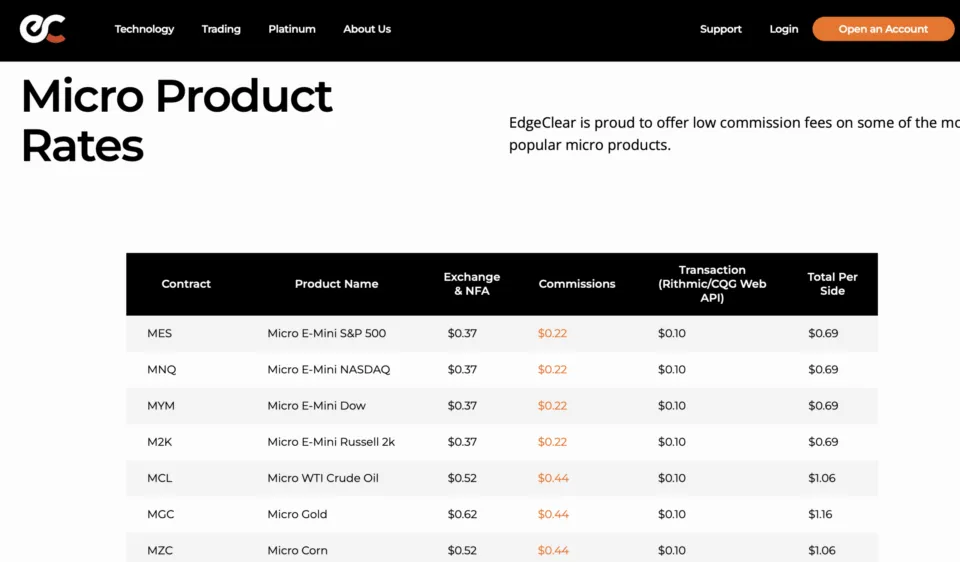
EdgeClear is a stripped-down US-regulated futures broker founded in 2019. For starters, we found the broker’s software integration impressive. EdgeClear is supported on 16 trading platforms, which consist of sophisticated names such as TradingView, Bookmap and Sierra Chart.
Traders can speculate on several popular futures markets connected to exchanges like the CME, Eurex, CBOT and CMEX.
This broker offers among the most reasonably priced trading commissions. Furthermore, traders can benefit from per-side transactions of $0.10/contract with a $20 monthly access fee to the Rithmic/CQG Web API (although the standard $0.22 is still pretty good).
| Information | EdgeClear |
|---|---|
| Regulators | CFTC (United States) |
| Minimum deposit | $500 |
| Supported Trading Platforms/Software | EdgePro, TradingView, RTrader Pro, Sierra Chart, Bookmap, CQG, MotiveWave, etc. |
| Available Accounts/Plans | Individual, Foreign Citizen, U.S Trust, Foreign Trust, Foreign Corporation, U.S. Partnership & LLC, Managed Futures |
| Available Futures | Indices, bonds, metals, energies, agriculture, forex, meats, softs |
| Minimum trading commissions (on MES) | $0.22 per side |
| Base Currencies Supported | Varies, but USD is primary |
| Payment Options | ACH, wire transfer, check |
| Deposit/Withdrawal Fees | Yes, $10-30 for withdrawals |
| Available Customer Support Channels | Live chat, phone, email |
| Countries Accepted |
Pros
- Low trading commissions
- Expansive trading software integration
- Wide selection of futures
- Broad choice of account types
Cons
- Withdrawal fees apply
- High minimum deposit
- No native mobile app
5. AMP Futures
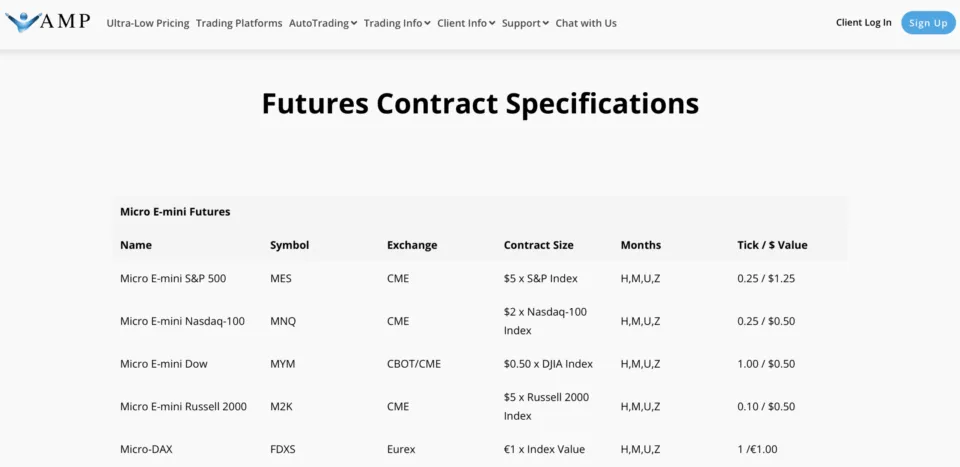
AMP Futures is a trusted futures broker for US clients, with roots dating back to 2004. Their experience makes them one of the best brokerages for variety. AMP claims it can beat any written trading commission (it also provides 20 commission-free positions for new clients).
Users can trade futures on 10 large, well-known exchanges with at least $100. The broker is integrated with more than 50 trading platforms. This ranges from the beginner-friendly MT5 to brands like TradingView, Bookmap, and SierraChart, which are suitable for advanced traders.
Another fantastic feature is that AMP Futures is one of the few brokers we tested that offers remote desktop support. This offers a more involved and quicker way to solve many technical issues.
| Information | AMP Futures |
|---|---|
| Regulators | CFTC (United States) |
| Minimum deposit | $100 |
| Supported Trading Platforms/Software | 50+, incl. MT5, TradingView, Sierra Chart, MotiveWave, Bookmap |
| Available Accounts/Plans | Individual, Joint, IRA, Corporate, LLC, Partnership, and Trust |
| Available Futures/Exchanges | CME, COMEX, IPE, NYMEX, Eurex, JPY, CBOE, HKEX, Singapore Exchange, ASX |
| Minimum trading commissions (on MES) | $0.50 per side |
| Base Currencies Supported | USD, EUR, GBP, CHF, PLN, AED, CAD, AUD, HKD, JPY, NZD, SGD |
| Payment Options | Wire transfer, ACH, checks |
| Deposit/Withdrawal Fees | Yes, $30 for wire transfers |
| Available Customer Support Channels | Live chat, phone, email, and remote desktop |
| Countries Accepted | 75+ (US-sanctioned nations and certain African, Asian, European, North/South American countries are excluded) |
Pros
- Highly experienced futures broker
- Massive trading platform compatibility
- Several account base currencies available
- Remote desktop support
- Reasonable minimum deposit
Cons
- Withdrawal fees apply
- Only regulated in the US
- No native mobile app
6. Optimus Futures
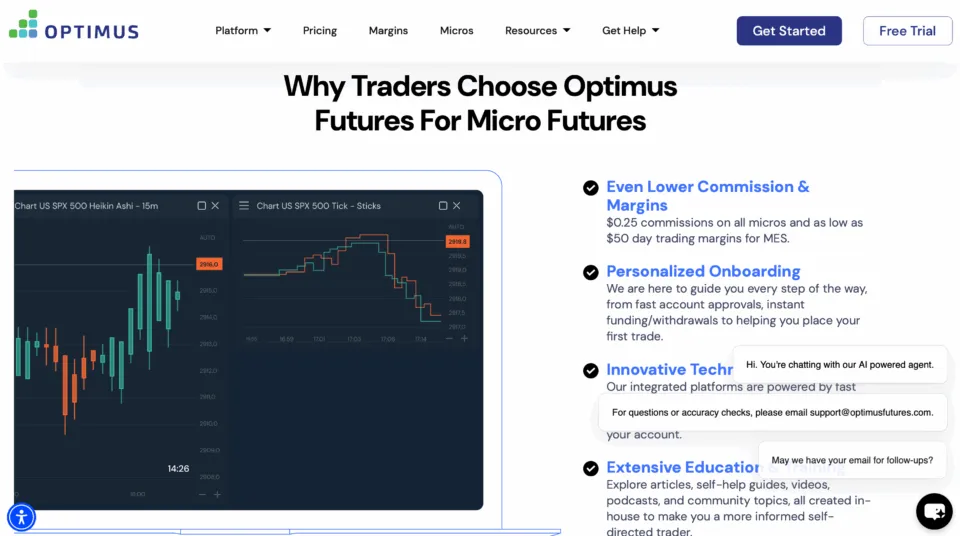
Optimus Futures has been serving traders since 2004. This trusted, US-regulated futures broker supports a wide range of ubiquitous trading platforms, along with its own proprietary software. The latter is especially noteworthy, as it freely offers DOM Surface 3D visualisation for order flow analysis.
Other perks are access to a free trading journal, real-time news updates, complimentary routing, and CME level 1 market data. The broker is well-suited for day trading and scalping enthusiasts with tight margin requirements and a commission structure that rewards higher volumes.
In addition to these features, Optimus Futures provides connectivity to 12 global exchanges, surpassing any other broker in our review. This ensures clients can access one of the broadest ranges of markets available.
| Information | Optimus Futures |
|---|---|
| Regulators | CFTC (United States) |
| Minimum deposit | $500 |
| Supported Trading Platforms/Software | 18, incl. MT5, TradingView, Sierra Chart, Bookmap, MotiveWave |
| Available Accounts | Individual, Joint, IRA, Superannuation, Corporate, LLC, Partnership, Trust |
| Available Futures/Exchanges | CME, CBOE, Eurex, Kansas City Board of Trade, ICE Futures US, ICE Futures Europe, NYSE Liffe US, NYSE Liffe, SGX, ASX, LME |
| Minimum trading commissions (on all micros) | $0.25 per side |
| Base Currencies Supported | USD |
| Payment Options | Wire transfer, ACH deposit, or physical check |
| Deposit/Withdrawal Fees | Yes, for some methods |
| Available Customer Support Channels | Live chat, phone, email, remote desktop |
| Countries Accepted | 150+ (US-sanctioned nations like Cuba, Iran, Venezuela, Syria, Libya, Sudan,Yemen and Belarus would be restricted) |
Pros
- Vast account range
- Among the cheapest in trading commissions
- Wide number of connected exchanges
- Remote desktop help provided
Cons
- High minimum deposit
- Withdrawal charges apply
- Only one base currency supported
7. Tradovate
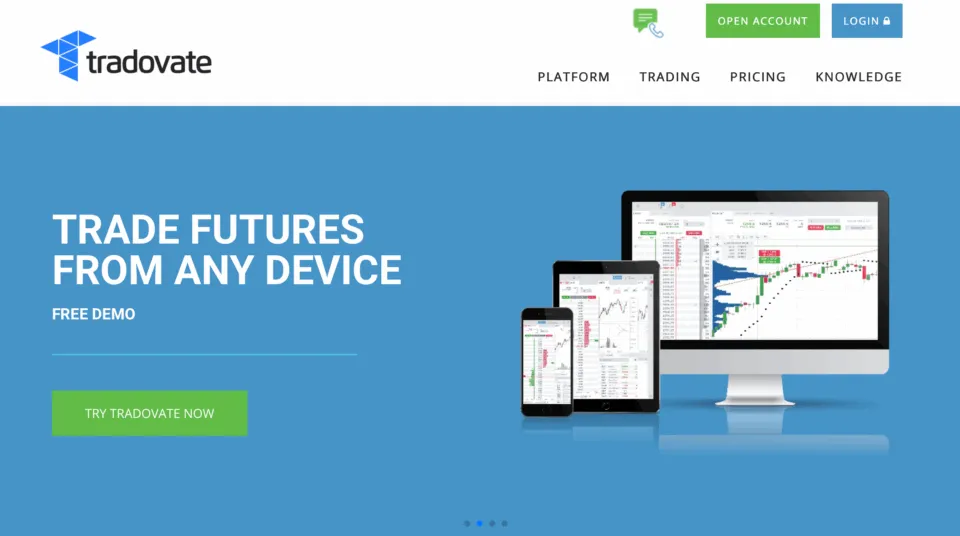
Tradovate is a futures broker founded in 2014 and a subsidiary of NinjaTrader. Like its parent company, Tradovate offers a free, monthly ($99) and a Lifetime plan (one-time payment of $1499). The latter offers trading commissions as cheap as $0.09 per side and access to all of the broker’s advanced charting tools.
Regardless of the plan, all live account users can enjoy free level 1 CME Group market data, access to TradingView, along with the broker’s flagship Market Replay, and the Order Flow+ tools.
We were impressed by the broker’s broad selection of futures. There are 13 individual markets, along with the same number of connected exchanges.
Tradovate was among the few futures brokers in our research that had their native mobile apps available on the Google Play Store and Apple App Store. Furthermore, the app is rated nearly 4/5 stars on the Play Store with over 500,000 downloads.
| Information | Tradovate |
|---|---|
| Regulators | CFTC (United States) |
| Minimum deposit | $5 |
| Supported Trading Platforms/Software | Tradovate (proprietary), Bookmap, Collective2, Daytradr |
| Available Accounts/Plans | Free, Monthly, Lifetime (across Individual, Joint, IRA, Corporate, LLC, Partnership, and Trust) |
| Available Futures/Exchanges | CBOT, CME Group, CME EC, Coinbase Derivatives, ICE, ICE Futures US, ICE Europe, Eurex, MGE, MIAX, NYMEX, CBOT, SMALL, |
| Minimum trading commissions (on MES) | $0.39 per side |
| Base Currencies Supported | USD, EUR, AUD, GBP, CAD |
| Payment Options | Debit card, ACH, wire transfer, mailed check |
| Deposit/Withdrawal Fees | Yes, $30 for wire transfer withdrawals (or currency equivalent) |
| Available Customer Support Channels | Live chat, phone, email |
| Countries Accepted | 75+ (US-sanctioned nations and certain African, Asian, European, North/South American countries are excluded) |
Pros
- Low-end trading commissions
- Accessible minimum deposit
- Decent range of base currencies
- Broad picks in futures/exchanges
- Well-rated mobile apps
Cons
- Plans may be too expensive for some
- Withdrawal charges apply
- Little third-party software integration
8. Interactive Brokers
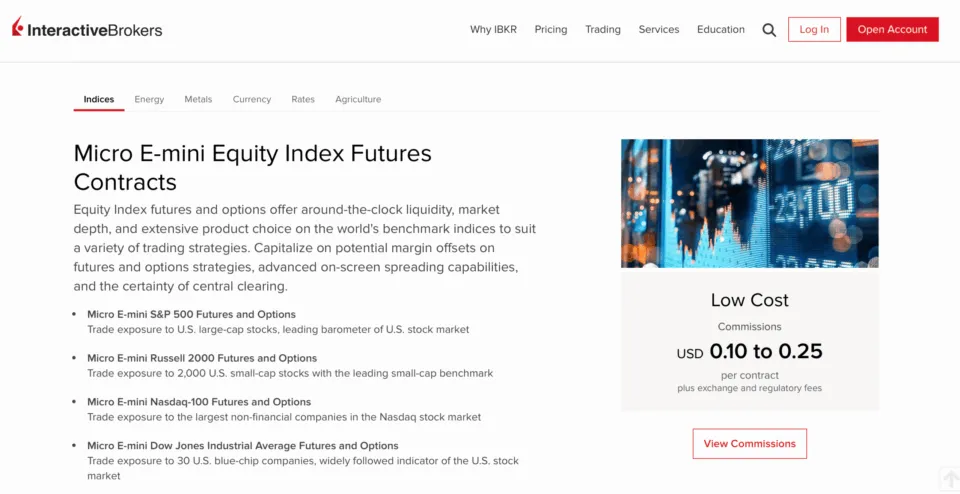
Interactive Brokers is a comprehensive, pioneering online trading platform founded in 1978. It is regulated by nine regulators across multiple continents (the highest among the names we reviewed).
Interactive Brokers is also among the few we examined that provide futures and futures options, a more complex alternative to traditional futures. Traders can fund their accounts in a massive range of base currencies (27), which is again the widest range compared to its competitors.
Interactive Brokers’ payment methods include the usual wire transfer, check and ACH. However, there are many other options specific to different regions, such as SEPA and transfers from Wise balance. This provides greater flexibility that is lacking with many futures brokers.
| Information | Interactive Brokers |
|---|---|
| Regulators | CFTC (United States), CBI (Ireland), CIRO (Canada), MAS (Singapore), SFC (Hong Kong), ASIC (Australia), BSE (India), FSA (Japan), CBH (Hungary), FCA (United Kingdom) |
| Minimum deposit | N/A |
| Supported Trading Platforms/Software | Trader Workstation (proprietary), TradingView, NinjaTrader, Zorro IB Bridge |
| Available Accounts/Plans | IBKR Lite, IBKR Pro (across Individual, Joint, Trust, Ira UGMA/UTMA) |
| Available Futures (incl. futures options) | Indices, bonds, energies, metals, agriculture, crypto, forex |
| Minimum trading commissions (on all micros) | $0.25 per side |
| Base Currencies Supported | AED, AUD, BGN, CAD, CHF, CNH, CZK, DKK, EUR, GBP, HKD, HUF, IDR, ILS, JPY, MXN, MYR, NOK, NZD, PLN, RON, SAR, SEK, SGD, USD, TRY, ZAR |
| Payment Options | Wire transfer, check, ACH (more available based on country) |
| Deposit/Withdrawal Fees | Yes, depending on the method |
| Available Customer Support Channels | Live chat, phone, email |
| Countries Accepted | 150+ (US-sanctioned nations like Cuba, Iran, Venezuela, Syria, Libya, Sudan, Yemen and Belarus would be restricted) |
Pros
- Regulated in multiple regions with decades of experience
- Offers futures and futures options
- Flexible payment methods
- Tremendous choice of base currencies
- Offers some of the lowest trading commissions
Cons
- Withdrawal costs are present
- Limited trading software integration
9. Ironbeam
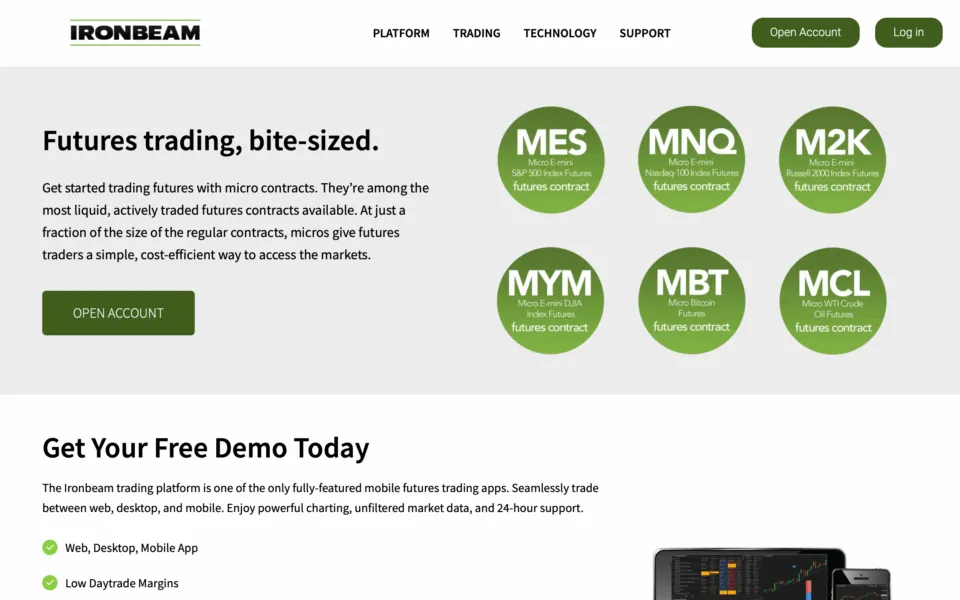
Ironbeam is a US-based futures brokerage started circa 2010-2011, promoting itself as ‘a platform, broker, and clearing firm all-in-one.’ Their offerings are well-suited for small accounts or for beginners while providing professional-grade perks.
Firstly, there is no minimum. There are 32 micro futures across five asset classes with low day margins starting from $50.
All live traders can empower themselves with free level 1 and 2 CME Group market data. For $39 monthly, traders gain access to this data across more futures and ‘Market by Order’ data on Ironbeam’s proprietary trading platform. On the other hand, Ironbeam can be integrated with eight other complex charting applications.
Another standout feature is that they provide 24-hour trade desk & technical support for live account holders. This is brilliant as traders can receive help more quickly than with other brokers.
| Information | Ironbeam |
|---|---|
| Regulators | CFTC (United States) |
| Minimum deposit | N/A |
| Supported Trading Platforms/Software | Ironbeam (proprietary), TradingView, Sierra Chart, CQG, Rithmic, MultiCharts, Bookmap, Jigsaw, MotiveWave |
| Available Accounts/Plans | Individual, Joint, IRA, Corporate/LLC, Trust, Partnership |
| Available Futures (incl. futures options) | Indices, oil, metals, forex, crypto |
| Minimum trading commission (on all micros) | $0.39 per side |
| Base Currencies Supported | USD |
| Payment Options | Wire transfer, ACH, check |
| Deposit/Withdrawal Fees | Yes, $40-60 for wire transfer and check |
| Available Customer Support Channels | Live chat, phone, email |
| Countries Accepted | 190+ (no official list; traders should enquire directly with the broker) |
Pros
- No minimum deposit
- Competitive trading commissions
- 24-hour professional support
- Offers futures options
Cons
- Limited market availability
- High withdrawal charges
- Only regulated for US clients
10. TradeStation
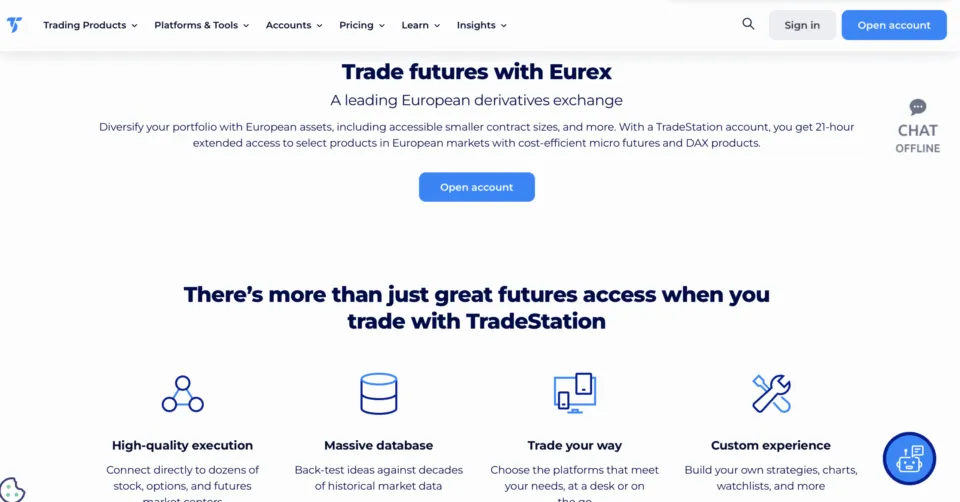
TradeStation is another long-standing US-based futures broker, established in 1982. Interestingly, they are loosely associated with Interactive Brokers. Users who sign up to TradeStation open an account connected to the latter. We saw some similarities between the two.
Firstly, the selection of account base currencies is extensive, with 23 options available. Traders can begin with no minimum deposit (and enjoy no platform fees and free real-time market data).
The selection of futures is excellent, covering both popular classes like forex and crypto and more niche ones like meats and softs. TradeStation also offers futures options, but unlike Interactive, we found their package more straightforward.
This package includes the possibility for zero commissions, free real-time data from several exchanges, access to multiple APIs and the dedicated ‘FuturesPlus’ software.
| Information | TradeStation |
|---|---|
| Regulators | CFTC (United States) |
| Minimum deposit | N/A |
| Supported Trading Platforms/Software | TradeStation (proprietary), TradersPost, QuantConnect, TradingView, Option Alpha, Multicharts, ORATS |
| Available Accounts/Plans | Individual, Joint, IRA, Entity |
| Available Futures (incl. futures options) | Indices, energies, metals, crypto, forex, softs, meats, agriculture, |
| Minimum trading commission (on all micros) | $0.50 per side |
| Base Currencies Supported | AUD, GBP, CAD, CNH, CZK, DKK,EUR, HKD,HUF, ISL, JPY, KRW, MXN, NZD, NOK, PLN, RUB, SGD, ZAR, SEK, CHF, TRY, USD |
| Payment Options | Wire transfer, check, ACH |
| Deposit/Withdrawal Fees | Yes, for withdrawals |
| Available Customer Support Channels | Live chat, phone, email |
| Countries Accepted | 150+ (US-sanctioned nations like Cuba, Iran, Venezuela, Syria, Libya, Sudan,Yemen and Belarus would be restricted) |
Pros
- Has existed for over 40 years
- No minimum deposit
- Offers futures and futures options
- Generous third-party software integration
Cons
- Only two supported payment options
- High minimum deposit ($5000) for futures options
- Withdrawal charges are present
How We Tested The Best Micro Futures Brokers:
When reviewing these brokers, a structured approach was applied, testing each broker against five core criteria: regulation, trading fees, supported platforms, customer support, and additional fees.
Regulation
The first step was to confirm that each broker operates under a recognized regulatory authority. From our work at WR Trading, this is non-negotiable, considering that futures trading involves real capital and leverage.
Regulation ensures brokers are held accountable for protecting client funds, handling deposits and withdrawals fairly, and maintaining ethical business practices.
Bodies like the CFTC (U.S.), ASIC (Australia), FCA (United Kingdom), or other top-tier regulators were those which we favoured the most.
Trading Fees
Micro futures are designed for cost efficiency, but commissions and exchange fees can quickly eat into profits if not competitive. We examined the per-side costs on markets like the Micro E-mini S&P 500 (MES), as well as whether brokers offered discounts for high-volume traders or commission-free trades for new clients. Brokers with reasonable trading commissions ranked higher in our analysis.
Still, there are other trading costs for futures traders which are not always reflected in the total commission. These include exchange, NFA and clearing and routing fees that apply with virtually all brokers.
Supported Platforms
Trading platforms are the backbone of the futures experience. We tested whether each broker supported industry standards like MetaTrader 5, TradingView, Bookmap, or Sierra Chart, alongside their own proprietary platforms. Platform support was evaluated not only on compatibility, but also on features such as DOM (Depth of Market), level 2 data, charting tools, and order flow analysis.
Customer Support
Futures markets operate almost 24 hours a day on most days of the week, and issues can arise at any time. That’s why we rated brokers on the availability and quality of their support.
We tested channels such as live chat, phone, and email, and paid attention to extras like remote desktop support, which can be invaluable for resolving technical problems quickly. Brokers offering 24/7 assistance naturally scored better.
Additional Fees
Finally, we examined the often-overlooked ‘non-trading’ costs. This included deposit and withdrawal fees, data subscriptions, inactivity charges, and platform licensing costs. The best brokers minimized or eliminated these hidden expenses, allowing traders to keep more of their gains
Which Micro Future Broker Is The Best For Beginners?
AvaFutures is the best platform for beginners to trade micro futures. Their package is quite straightforward as the newest futures broker on this list. This consists of reasonable trading commissions, two account types, three integrated trading platforms, two base currencies and no deposit/withdrawal costs.
Finally, AvaFutures is regulated in many regions in the world (more than other brokers), making it more accessible.
Which Broker For Micro Futures Is The Cheapest?
EdgeClear proved to be the most affordable micro futures broker in our research. However, other names that had their margins and commissions low on standard plans are Optimus Futures, Tradovate and Interactive Brokers.
Users should always remember that the true execution costs will vary based on the traded asset. Finally, tiered-volume rates are more cost-effective than those for individual trades.
To facilitate a more accurate comparison, we will show the per-side commission for trading gold (MGC) and the S&P 500 on micro contracts for each broker.
| Broker | Micro Gold future commission | Micro S&P 500 commission |
|---|---|---|
| AvaFutures | $0.75 | $0.75 |
| Plus500 | $0.49 | $0.49 |
| NinjaTrader | $0.39 | $0.39 |
| EdgeClear | $0.22 | $0.22 |
| AMP Futures | $0.85 | $0.50 |
| Optimus Futures | $0.25 | $0.25 |
| Tradovate | $0.39 | $0.39 |
| Interactive Brokers | $0.25 | $0.25 |
| Ironbeam | $0.39 | $0.39 |
| TradeStation | $0.50 | $0.50 |
How To Create Your Micro Futures Account
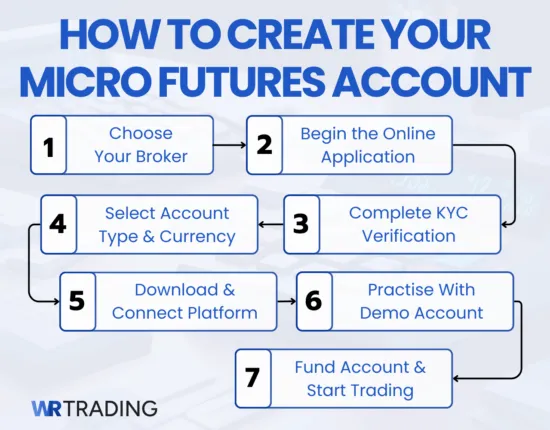
Opening a micro futures trading account is straightforward, although the process may be slightly trickier with advanced brokerages. Most have everything online, allowing you to often get started in under an hour. Account approval may take up to a few days in rare cases, when necessary to properly verify the trader.
Nonetheless, here’s the step-by-step process:
1. Choose Your Broker
Start by selecting a regulated broker that supports micro futures. The choice will depend on several factors we have reviewed, including fees, platform compatibility, available markets, and customer support.
For beginners, consider brokers with basic account structures (e.g., AvaFutures, Plus500 US, Ironbeam). Meanwhile, the likes of Optimus Futures, AMP Futures, TradeStation and Interactive Brokers are suitable for advanced traders (and even intermediates).
2. Begin the Online Application
Once the broker has been chosen, head to their website and click ‘Open an Account,’ ‘Sign Up,’ or similar call-to-action. One is typically asked for:
- Full name, email, phone number, and residential address.
- Country of residence (to determine regulatory requirements).
- Trading experience and financial background (brokers must check suitability).
Most forms are user-friendly, and you can complete this step in about 10–15 minutes.
3. Complete KYC Verification
Because futures accounts are regulated, traders need to pass Know Your Customer (KYC) checks:
- Upload a government-issued ID (a passport or driver’s license is usually sufficient).
- Submit proof of address (a utility bill or bank statement from the last 3 months should do).
Some brokers also ask for proof of income or net worth to confirm you understand the risks of leveraged trading. With automated systems, this can be approved within a few hours; however, in some cases, it may take up to 2–3 days.
4. Select Your Account Type & Base Currency
Select from the available account plans (e.g., Standard, Individual, Joint) and determine whether each option is paid or free. Many micro futures brokers offer simplified accounts with USD as the default base currency, though some (like Interactive Brokers, NinjaTrader and AMP) support a much wider range.
5. Download and Connect The Trading Platform
Most brokers will email instructions on how to connect your account to a supported platform. This often involves:
- Downloading the platform (e.g., MT5, TradingView, or the broker’s proprietary software).
- Logging in with the username, password, and server details provided by your broker.
- Adding micro futures symbols (e.g., MES for Micro E-mini S&P 500; MGC for trading gold).
6. Practise With a Demo Account First
Nearly all brokers offer free demo accounts. It’s imperative to test the trading software and strategy for an extended period using virtual funds before trading live. This step has no risk and helps build confidence.
7. Fund Your Account And Start Trading
Once a trader is confident and comfortable, they can consider switching to a live account. When making your first deposit, it’s crucial only to contribute disposable funds (money you can afford to lose), considering the speculative nature of trading.
Funding options typically comprise bank wire, ACH, debit/credit card, or e-wallets like Skrill/Neteller. We recommend using cards as the primary choice (or alternatively e-wallets) as they are the most used, are much cheaper, and faster to process.
The aim is to start small; that’s the purpose of micro futures. They offer lower margin requirements and reduced tick values compared to standard futures, providing a space to trade without overexposure.
How Much Money Do You Need For Trading Micro Futures?
We believe a minimum balance of $1000 is ideal. It facilitates better risk management on many markets and reduces the potential for margin calls. Of course, how much you actually need also depends on the specific market and trading frequency.
At WR Trading, we’ve noticed that many retail traders underestimate the extent of margin requirements, which is another critical determining factor.
What Are the Margin Requirements Of Micro Futures Brokers?
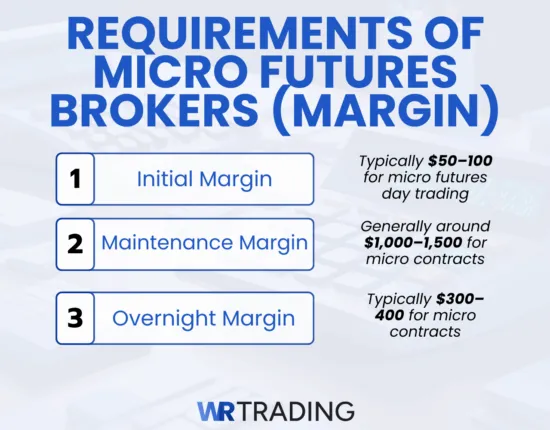
In our testing, $50 was a common day trading margin requirement for micro futures brokers. In other cases, this figure can reach up to $100.
Margin requirements in futures trading refer to the minimum amount of capital that must be deposited to open and maintain a position. Futures contracts are leveraged instruments where traders simply commit a fraction of a contract’s total value for each position, i.e., margin.
These are generally the types of margin to note when trading futures (each of which constantly changes):
- Initial margin: the minimum amount you must have in your account to open a position (often set by the exchange).
Micro futures traders will also frequently see ‘intraday margins’ or ‘day trading margins,‘ which are discounted margins set by the brokers.. In such a case, this would be the initial margin.
The main rule is that positions should be closed on the same day before a particular market closes (usually 15–30 minutes beforehand). Failure to do so results in a liquidation fee for every trade.
- Maintenance margin: Opening a futures trade doesn’t stop at the initial margin. The maintenance margin, set exclusively by the exchange, is necessary to keep it open. This figure is significantly higher (depending on the asset) than the initial margin, reinforcing the need for larger deposits beyond the promoted minimum.
For example, Optimus Futures’ day trading and maintenance margins for trading a micro DAX future (FDXS) are $325 and $1300, respectively.
- Overnight margin refers to the margin required to carry a futures trade beyond the daily close to cover overnight risk. Many brokers may simply present initial and overnight margins (instead of mentioning the maintenance part) for simplicity’s sake. For instance, trading the E-Micro EUR/USD (ME6) on AvaFutures requires a minimum initial margin of 68€ and an overnight margin of 340€.
Conclusion: AvaFutures Is The Best Micro Futures Broker
After researching and testing ten leading providers, AvaFutures emerged as the best overall broker for micro futures trading. Despite being relatively new, it benefits from AvaTrade’s established reputation and is one of the best regulated.
At WR Trading, we tested AvaFutures with real money accounts. The experience confirmed what our research suggested: an uncomplicated account setup, transparent pricing, commission-free trades for new users, and free CME level 2 data. These features make it equally appealing for beginners seeking a simple entry point and for advanced traders looking for competitive conditions.
That said, the competition has its standouts too:
- Plus500 US is ideal for US citizens seeking an accessible and low-cost gateway into micro futures, with no hidden platform or data fees.
- NinjaTrader shines for active traders who value advanced charting tools and premium software packages.
- EdgeClear offers some of the lowest commissions in the industry.
- AMP Futures impresses with its compatibility across more than 50 platforms.
- Optimus Futures leads the pack in exchange connectivity,
- Interactive Brokers remains unmatched for global regulation, flexible funding, and multi-currency support.
In the end, your choice should ultimately come down to what matters most: low costs, market variety, advanced trading tools, and flexibility.
Once again, these are the 10 best Micro Futures Brokers:
- AvaFutures (best overall)
- Plus500 US (best for US traders)
- NinjaTrader (best for premium charting software)
- EdgeClear (best for lowest trading commissions)
- AMP Futures (best for trading software compatibility)
- Optimus Futures (best for high number of connected exchanges)
- Tradovate (best for mobile futures trading)
- Interactive Brokers (best for flexible payment methods)
- Ironbeam (best for customer support)
- TradeStation (best for futures options)












